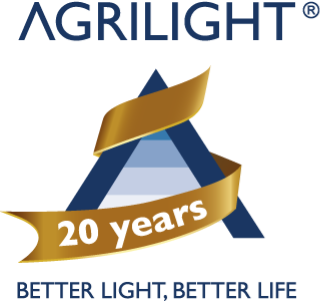Agrilight b.v. has a unique understanding of lighting technology and the targeted use of lighting for different types of livestock. Light intensity, light distribution, day length and light colour all have implications for animal welfare and therefore animal behaviour. The right balance between these four factors has a positive influence on the livestock. Correct, uniform lighting helps to improve health and productivity, amongst other things.
It is important to know that our advice about a lighting regime always takes account of the following factors:
• scientific basis;
• animal welfare;
• durability;
• practical experience.
As well as providing good working conditions, a good lighting system ensures optimum colour recognition by the animal. A good light level also means that any signs of disease can be spotted at an early stage. Lighting also stimulates growth in fattening pigs. In a nutshell, a sophisticated lighting regime makes an essential contribution to animal welfare and higher productivity.
Of course, it is important for the lighting system to be durable and capable of withstanding the climate in the house.
Pregnant sows
In sows, good lighting can stimulate oestrus. Sows reproduce seasonally rather than all year round. They naturally come into oestrus in the spring. Short, dark days slow down this process. The lighting regime can extend the shorter days of the year. Agrilight b.v. recommends maintaining a minimum of 150 lux for 16-18 hours, followed by 8-6 hours of darkness.
This light level and lighting regime imitate the best time for oestrus (spring).
Farrowing sows
A farrowing house needs 16 hours of light followed by an 8-hour period of darkness. With farrowing sows, it is important to stimulate piglet growth. If the periods of light are long(er), the piglets have more opportunity to drink, so the amount of milk consumed increases. Good lighting therefore results in better piglet growth. It also improves the survival chances of the weaker piglets.
In addition to the lighting regime described above, Agrilight b.v. recommends an average light level of 100 to 150 lux. The same applies to weaned piglets and fattening pigs. Extending the day length means that every animal, including the lower-ranking ones, has plenty of opportunity to use the drinking or feeding trough.
Fattening pigs
Research shows that lighting in livestock housing is a very important means of increasing the feed intake of fattening pigs, which means that the pigs reach their final weight faster. This can be achieved with a light level of 100 lux. A good light level also ensures that the livestock farmer can work effectively. It is easier to work and to spot any signs of disease when the light level is good. A lighting regime of 16 hours of light followed by 8 hours of darkness is also appropriate here.
Breeding sows
Although the presence of the boar has a major influence on breeding sows, a good light level and lighting regime are also very important. Agrilight b.v. recommends a light level of 150 lux and a lighting regime of 8 hours of light followed by 16 hours of darkness.
Service pen
A number of studies have demonstrated that good lighting in the service pen stimulates oestrus and promotes good ovulation. A light level of 200 to 300 lux is not an excessive luxury in a service pen – it is good for the farmer as well as the pigs. Good lighting makes it is easier to work and to spot any signs of disease. The lighting regime used here is the same as in the farrowing pens – 16 hours of light followed by 8 hours of darkness.
An unsuitable light level or lighting regime may have implications for the health, performance and welfare of your livestock. That’s why you should always seek advice before purchasing lighting for your livestock housing. We can draw up a free, no-obligation lighting plan that will set out all the benefits of a good, well-designed light level.






